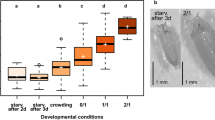Abstract
Larvae which demonstrated long trails covering a large area while feeding (rover foragers) pupated significantly higher than those covering a relatively small area and exhibiting short paths (sitter foragers). Pupation height and density of larvae per vial were positively correlated. Under the condition of equal larval density per vial,rovers were found to pupate significantly higher thansitter larval foragers. The effect of three light regimes (constant light, constant darkness, and 12 h light followed by 12 h dark) indicated a more complex relationship between pupation height and larval foraging behavior.
Similar content being viewed by others
References
Alvarez, G., Farina, J., and Fontdevila, A. (1979). Density and frequency-dependent selection on the singed locus ofDrosophila melanogaster.Genetica 50(3):161–166.
Bakker, K. (1961). An analysis of factors which determine success in competition for food among larvae ofDrosophila melanogaster.Arch. Neerl. Zool. XIV:200–281.
Barker, J. S. F. (1971). Ecological differences and competitive interaction betweenDrosophila melanogaster andDrosophila simulans in small laboratory populations.Oecologia 8:139–156.
Bos, M., Burnet, B., Farrow, R., and Woods, R. A. (1977). Mutual facilitation between larvae of the sibling speciesDrosophila melanogaster andDrosophila simulans.Evolution 31:824–828.
Burnet, B., Sewell, D., and Bos, M. (1977). Genetic analysis of larval feeding behavior inDrosophila melanogaster. II. Growth relations and competition between selected lines.Genet. Res. Cambr. 30:149–161.
Dawood, M. M., and Strickberger, M. W. (1964). The effect of larval interaction on viability inDrosophila melanogaster. I. Changes in heterozygosity.Genetics 50:999–1007.
Dawood, M. M., and Strickberger, M. W. (1969). The effect of larval interaction on viability inDrosophila melanogaster. III. Effects of biotic residues.Genetics 63:201–211.
de Souza, H. M. L., da Cunha, A. B., and dos Santos, E. P. (1970). Adaptive polymorphism of behavior evolved in laboratory populations ofDrosophila willstoni.Am. Nat. 104:175–189.
Grossfield, J. (1978). Non-sexual behavior of Drosophila. In Ashburner, M., and Wright, T. R. F. (eds.),The Genetics and Biology of Drosophila, Vol. 2b, New York, Academic Press, pp. 1–126.
Hoenigsberg, H. F. (1968). An ecological situation which produced a change in the proportion ofD. melanogaster toD. simulans.Am. Nat. 102:389–390.
Jacobs, M. E. (1961). The influence of light on gene frequency changes in laboratory populations of ebony and non-ebonyDrosophila melanogaster.Genetics 46:1089–1095.
Jones, L. P., and Barker, J. S. F. (1966). Polymorphism at the ebony locus ofDrosophila melanogaster and population fitness.Genetics 53:313–326.
Kawanishi, M., and Watanabe, T. K. (1978). Difference in photo-preferences as a cause of coexistence ofDrosophila simulans andD. melanogaster in nature.Jap. J. Genet. 53:209–214.
Kearsey, M. J., and Kojima, K. (1967). The genetic architecture of body weight and egg hatchability inDrosophila melanogaster.Genetics 56:23–37.
Markow, T. A. (1979). A survey of intra- and interspecific variation for pupation height inDrosophila.Behav. Genet. 9:209–218.
Matheson, A. C., and Parsons, P. A. (1975). Long-term exposure to CO2 inDrosophila melanogaster andDrosophila simulans, using isofemale strains from natural populations.Am. Nat. 109:593–595.
Mensua, J. L. (1967). Some factors affecting pupation height ofDrosophila.Dros. Inform. Serv. 42:76.
McCoy, C. E. (1962). Population ecology of the common species ofDrosophila in Indiana.J. Econ. Entomol. 55:978–980.
McKenzie, J. A., and McKechnie, S. W. (1979). A comparative study of resource utilization in natural populations ofDrosophila melanogaster andD. simulans.Oecologia 40:299–309.
Mishima, J. (1964). The competition amongDrosophila larvae in different growth stages.Res. Pop. Ecol. 6:22–27.
Moree, R. (1952). Experimental measurement of the relative viability of the mutant ebony inDrosophila melanogaster.Am. Nat. 86:45–48.
Moth, J. J., and Barker, J. S. F. (1977). Interspecific competition betweenDrosophila melanogaster andDrosophila simulans: Effects of adult density on adult viability.Genetics 47:203–218.
Ohnishi, S. (1979). Relationship between larval feeding behavior and viability inDrosophila melanogaster andDrosophila simulans.Behav. Genet. 9:129–134.
Parsons, P. A. (1975). The comparative evolutionary biology of the sibling speciesDrosophila melanogaster andDrosophila simulans.Q. Rev. Biol. 50:151–169.
Sameoto, D. D., and Miller, R. S. (1968). Selection of pupation site byDrosophila melanogaster andD. simulans.Ecology 49:177–180.
Sewell, D., Burnet, B., and Connolly, K. (1975). Genetic analysis of larval feeding behavior inDrosophila melanogaster.Genet. Res. Cambr. 24:163–173.
Sokal, R. R., and Rohlf, R. (1969).Biometry, W. H. Freeman, San Francisco.
Sokal, R. R., Ehrlich, P. R., Hunter, P. E., and Schlager, G. (1960). Some factors affecting pupation site ofDrosophila.Ann. Entomol. Soc. Am. 53:174–182.
Sokolowski, M. B. (1980). Foraging strategies ofDrosophila melanogaster: A chromosomal analysis.Behav. Genet. 10:291–302.
Sokolowski, M. B. (1981).Evolutionary Strategies in Drosophila:Genetic Analyses, Doctoral thesis, University of Toronto, Toronto, Ontario.
Sokolowski, M. B. (1982a).Drosophila larval foraging behavior: Digging.Anim. Behav. 30:1252–1253.
Sokolowski, M. B. (1982b).Rover andsitter larval foraging patterns in a natural population ofD. melanogaster.Dros. Inform. Serv. 58:138–139.
Sokolowski, M. B. (1982c). Temporal patterning of foraging behavior inD. melanogaster larvae.Dros. Inform. Serv. 58:139–141.
Sokolowski, M. B., and Hansell, R. I. C. (1983).Drosophila larval foraging behavior. I. The sibling species,Drosophila melanogaster andD. simulans.Behav. Genet. 13:159–168.
Sokolowski, M. B., Hansell, R. I. C., and Rotin, D. (1983).Drosophila larval foraging behavior. II. Selection in the sibling speciesDrosophila melanogaster andD. simulans.Behav. Genet. 13:169–172.
Tantaway, A. O., and Soliman, M. H. (1967). Studies on natural populations ofDrosophila. IV. Competition betweenDrosophila melanogaster andDrosophila simulans.Evolution 21:34–40.
Weisbrot, R. D. (1966). Genotypic interactions among competing strains and species ofDrosophila.Genetics 53:427–435.
Author information
Authors and Affiliations
Additional information
This research was supported by an NSERC Graduate Fellowship and University of Toronto Open Fellowship to M. B. Sokolowski and NSERC Operating Grant N505 to R. I. C. Hansell.
Rights and permissions
About this article
Cite this article
Sokolowski, M.B., Hansell, R.I.C. Elucidating the behavioral phenotype ofDrosophila melanogaster larvae: Correlations between larval foraging strategies and pupation height. Behav Genet 13, 267–280 (1983). https://doi.org/10.1007/BF01071872
Received:
Accepted:
Issue Date:
DOI: https://doi.org/10.1007/BF01071872




